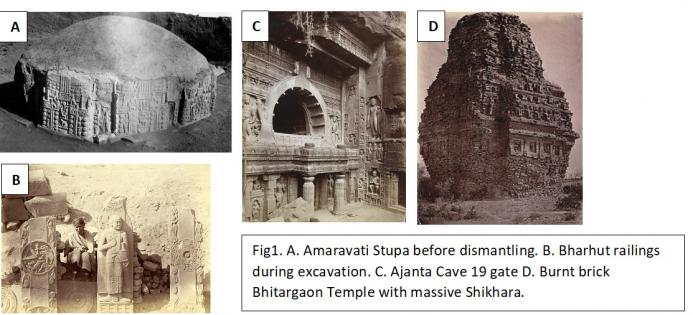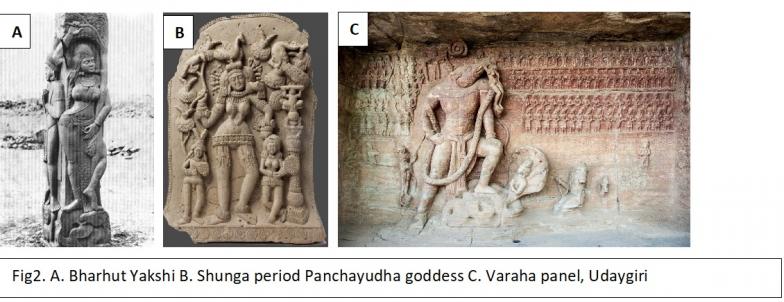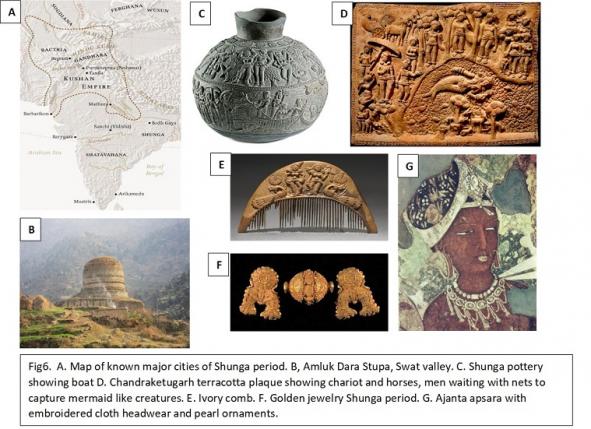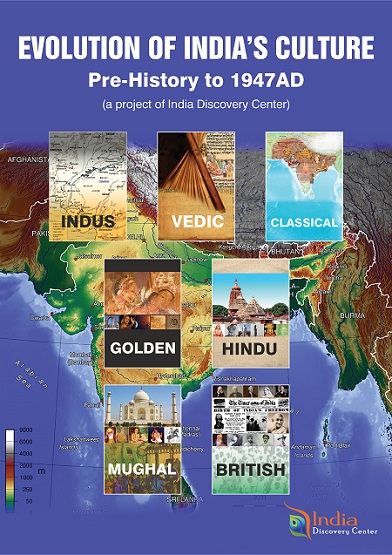Archives
Contribute
|
|
The Golden Period (200BCE- 500CE) - Art And Culture
|
|
Krishnakali Dasgupta
06/10/2021
The Golden period produced some of the greatest wealth of Literature, Art and Architecture of the Indian subcontinent. Both Bharhut and Sanchi stupas were enlarged and decorated with beautifully engraved timber railings, while others were freshly commissioned (Amaravati). Magnificent rock cut prayer halls (Chaitya Griha- enclosing a stupa) and adjacent simple living quarters (Viharas) were excavated for Buddhist and Jain monks in central and southern India. The entrance, vaulted ceilings, pillars, and stupa of the prayer halls were designed to mimic contemporary wooden architecture (buttresses, window panels, encasings) but later all surfaces were intricately carved with ornamental designs. Inscriptions at the sites note that the caves were commissioned by royalty, rich local and foreign merchants, and crowdfunded by common people. Highly skilled craftsmen’s guilds provided the stone masons, sculptors, carpenters, and painters for these commissioned projects.
Massive wealth of wood, stone and terracotta sculptural work give insight into contemporary iconography. Bharhut and Sanchi railings are heavily engraved with non-idolic representation of the Buddha (Hinayana style), Buddha’s life scenes, Mayadevi, fantastic winged apsaras and beasts, foliage designs, Ashoka’s pillars, and capitals and magnificent Yakshas and Yakshis (most recognisable and omnipresent pre-Buddhist forest deities). They were venerated as wise beings that guarded wealth (material and spiritual) and were heavily associated with various contemporary flora and fauna.  Massive amounts of terracotta plaques unearthed from Sunga areas show an unidentified fertility Goddess with 5 -10 weapons in her giant coiffure. In the Mahayana era, large scale stand-alone ‘lifelike’ sculptures of Buddha became popular. While the Gandhara school from North-west under Greco-Roman influence focused on anatomical precision (body and facial), textile detail and a ‘Somber’ expression in their Bodhisattvas on Grey- blue Schist, the central Indian Mathura school produced fleshy and lively Buddhas, Jinas, Yakshis and Hindu gods and goddesses from characteristic red sandstone. Rock cut caves with Hindu iconography (Udaygiri), stand-alone Hindu temples in stone (Deogarh) and burnt brick (Bhitargaon) are first observed during the Guptas.
The Ajanta caves also serve as a prime example of the magnificent dry-mural paintings produced during this period. Various episodes from the Jataka Tales and portraits of Buddha are painted in massive canvases, with the whole story narrated in a single frame with different scenes blending into each other. The highly animated characters are painted in various poses of activity and varied skin tonality, wearing brightly coloured costumes and shimmering gold jewelry. Their theatrical presentation corroborates the importance of drama and theatre to contemporary society, as supported by production of a large number of excellent Sanskrit plays during the period. The Natyashastra (pan-Indian contemporary dramatic treatise) speaks of highly technical classical dance forms, musical instruments, and vocal compositions. Skilled dancers and musicians are abundant on the Ajanta murals, Bharhut railings and the Sanskrit plays. Tamil Sangam literature (including ‘Silappadikaram' and ‘Manimekalai’ - both involving celebrated dancers) belong to this period. The renowned Sanskrit poet and playwright Kalidasa’s in his ‘Meghaduta’ chooses a Yaksha as his protagonist and describes the geographical route between Ramgiri (current Nagpur) to Alakapuri (near Mount Kailash in the Himalayas), mentioning the important cities along the way.
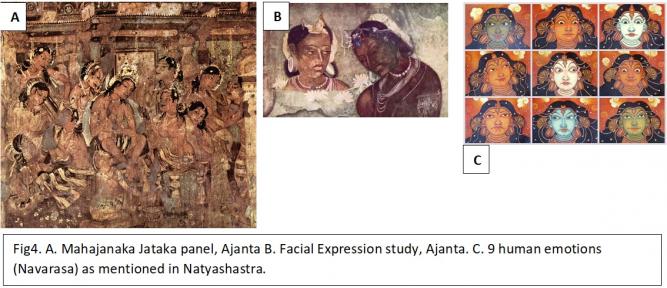
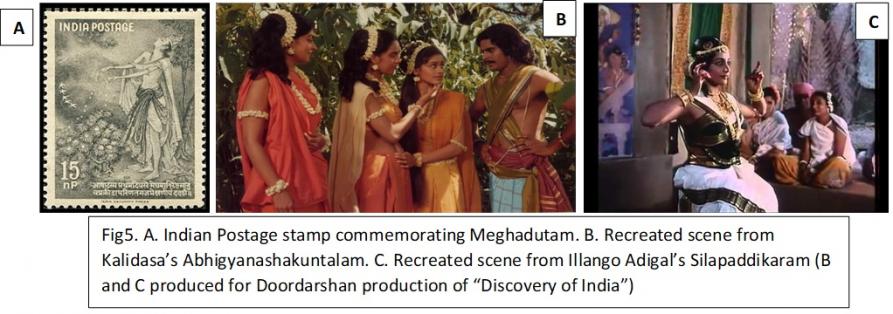 Excavations have unearthed numerous well-planned towns all over India with elaborate fortifications, defense walls, well planned streets, permanent mud brick houses, pillared halls, open courtyards, drains, granaries, terracotta ring wells, stupas, shrines, apsidal temples, and elaborate brick tanks. Luxury household items of wood, ivory, terracotta, bone, glass, gold and semi-precious gems, and fine pottery of delicately painted and stamped red and grey ware and Black slipped ware depicting numerous scenes of general life are abundant. Sanchi friezes show multi storied and high vaulted buildings with large open windows covered with heavy drapery. Kalidasa mentions Chinese silk and Silappadikaram mentions Madurai cloth merchants selling cotton, animal wool and silk clothing. Ajanta paintings and Sunga terracotta plaques show both stitched and unstitched garments, printed designs and fine embroidery, while dancers and royalty wear pearls, precious gems, heavy golden jewelry, and massive hairpins in elaborate coiffures.
The archeological and literary sources all bespeak a bustling sophisticated city-based society, with abundantly wealthy trading and ruling classes supporting unhindered development of art and culture.
Supplementary Reference Lists: Dynasties supporting major Architecture and Art Commissions: Sanchi and Bharhut Stupa - Maurya, Sunga, Satavahana
Ajanta - Satavahana, Vakataka, Gupta
Udaygiri and Khandagiri caves- Kharavela
Udaygiri caves (Vidisha)- Gupta Major Stupas: Bharhut, Sanchi, Amaravati Imp cave clusters: Buddhist - Bhaja, Karle, Ajanta, Pandavleni (Maharashtra); Jain - Sittanavasal (TN), Udaygiri-Khandagiri (Odisha); Hindu - Udaygiri (Vidisha MP) Early Hindu structures - Vasudev temple complex (Vidisha/Besnagar), Heliodorus’s Garuda Pillar at Vidisha Vasudev Temple complex, Dasavatara Temple (Deogarh, UP), Bhitargaon Temple (UP) Buddha non-idolic iconography - Stupa, throne, bodhi tree, dhammachakra, foot, lotus etc Hindu iconography- Vishnu avataras (Samkarshana, Matsya, Kurma, Varaha, Rama), Shivalinga, Shakti, Ganesha, Kartikeya, Surya, Indra, Samudra, Brahma, Ganga (with Makara (crocodile)), Yamuna (with Kurma (tortoise) Foreign merchants - Yavanas (Greeks), Pallavas (Parthians), Shakas (Scythians) Sanskrit playwrights (Major work) - Bhasa (4th cent BC) (Swapnavasavdattam), Ashwaghosha (Buddhacharita), Sudraka (Mrichhakatikam), Vishakhadatta (Mudrarakshasa), Kalidasa (Abhijnanashakuntalam) Topics of the Natyashastra - Types of Drama, Playwriting, Characters of a play, Dance, Music, Instruments (Metal, Wind, Strings, Percussion), Acting, Direction, Stagecraft, Costume design etc Ajanta Musicians play - lutes, flutes, cymbals, and drums. Excavated towns - Pushkalavati, Sirkap (Taxila), Hastinapur, Mathura, Sringaverapura, Sravasthi, Kaushambi, Ujjaini, Vidisha, Vaishali, Mahasthangarh etc City coins - Tripuri, Ujjain, Kaushambi, Vidisha, Mahishmati, Madhyamika, Varanasi, Taxila. Grains recovered- Cereals (rice, barley, wheat), Pulses (Chickpeas, lentil, grass pea, black gram), Oil seeds (field brassica, sesame), Spices (Fenugreek, coriander, cumin, black pepper), Fruits (date, custard apple, walnut, almond, jamun) Fiber crops – Cotton, Dye - Henna Scenes from life on pottery - hunting, fishing, bathing, bridal parties, weaving, women dressing, kitchen activities, hermits at their hermitage, boats, chariots, palanquins, armory, horses, elephants etc Luxury items - wood and ivory (mirror, dice, combs), terracotta (votive tanks, crucibles, bangles, pottery), bone, glass, gold, and semi-precious gems (jewelry, decorative items, crockery) Main jewelry - waist girdles, anklets and armlets, ear ornaments References: 1. A History of Ancient and Medieval India. Upinder Singh. 2018 impression. 2. The Wonder that was India. A.L. Basham. 3rd edition. 3. The Civilisation of India. R.C. Dutt.1995 4. INDIA. An Archeological History. Paleolithic History to Early Historic Foundations. D.K, Chakrovarty. 2nd Edition. 6. The archeology of early historic South Asia. F.R Allchen. 1995. 7. Ancient Indian and Indo-Greek theatre. M L Varadpande. 1981 8. Shilpe Bharat o Bohirbharat (Bengali). Manindrabhushan Gupta. 1995. 9. A Cultural History of India. A.L. Basham. 1975 10. Foreign Influence on Ancient India. K.C. Sagar. 1992. 11.https://www.encyclopedia.com/environment/encyclopedias-almanacs-transcripts-and-maps/iconography-buddhist-iconography 12. https://www.indiadiscoverycenter.org/ac/acgolden/ Picture References: https://scroll.in/article/807101/forget-the-kohinoor-could-we-have-the-amaravati-stupa-sculptures-back-please https://www.outlookindia.com/outlooktraveller/photos/bhaja-caves-entrance/14298 https://www.sensesatlas.com/territory/architecture/rock-cut-architecture-of-india-the-ajanta-caves/ http://www.indian-heritage.org/painting/ajanta/ajanta10.html https://www.khanacademy.org/humanities/art-asia/south-asia/x97ec695a:1000-b-c-e-500ce-indo-gangetic-plain/a/a-buddha-from-mathura https://www.classicalclaps.com/natya-shastra-an-overview/ Dr. Krishnakali Dasgupta leads the Art and Culture track in India Discovery Center's project on "Evolution of Indian Culture: Pre-history to 1947AD"
More information and updates on the project are available at
https://www.facebook.com/Evolution-of-Indian-Culture-An-IDC-Project-107749391111922 More information on India Discovery Center is available at https://www.indiadiscoverycenter.org (c) Copyright 2021 India Discovery Center, Inc. All rights reserved.
 |
|
You may also access this article through our web-site http://www.lokvani.com/
|
|
